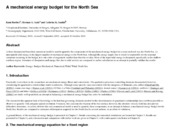| dc.contributor.author | Barthel, Knut | eng |
| dc.contributor.author | Gade, Herman G. | eng |
| dc.contributor.author | Sandal, Cathrine K. | eng |
| dc.date.accessioned | 2004-06-29T08:04:18Z | en_US |
| dc.date.accessioned | 2004-08-03T13:01:28Z | en_US |
| dc.date.accessioned | 2004-08-26T11:59:34Z | |
| dc.date.available | 2004-06-29T08:04:18Z | en_US |
| dc.date.available | 2004-08-03T13:01:28Z | en_US |
| dc.date.available | 2004-08-26T11:59:34Z | |
| dc.date.issued | 2004-06-29T08:04:18Z | eng |
| dc.Published | Continental Shelf Research 2004 24(2): 167-181 | en |
| dc.identifier.issn | 0278-4343 | en_US |
| dc.identifier.uri | https://hdl.handle.net/1956/433 | |
| dc.description.abstract | A three-dimensional baroclinic numerical model is used to quantify the components of the mechanical energy budget for a semi-enclosed sea, the North Sea. As anticipated, tidal energy is the largest supplier of mechanical energy to the North Sea. Although the energy supply due to winds is responsible for the seasonal variations occurring in the budget, it is one order of magnitude smaller than that due to tides. Most of the input tidal energy is dissipated, specifically in the shallow southern region. Estimates of dissipation and energy flux due to tidal activity are compared to earlier calculations in an attempt to partially validate the results. | en_US |
| dc.format.extent | 41137 bytes | eng |
| dc.format.extent | 969727 bytes | eng |
| dc.format.extent | 183 bytes | eng |
| dc.format.mimetype | text/plain | eng |
| dc.format.mimetype | application/pdf | eng |
| dc.format.mimetype | text/plain | eng |
| dc.language.iso | eng | eng |
| dc.publisher | Pergamon | en_US |
| dc.title | A mechanical energy budget for the North Sea | en_US |
| dc.type | Journal article | |
| dc.identifier.doi | https://doi.org/10.1016/j.csr.2003.10.006 | |
